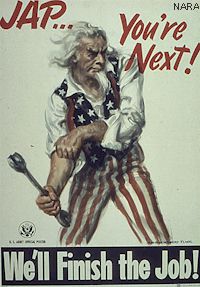"Hit hard, hit fast, hit often."
Admiral William F. Halsey
On the evening of 22 January 1944, under the watchful eyes of Undersecretary of the Navy
James Forrestal and Fleet Admiral Chester Nimitz, an enormous striking force, designated Task
Force 58, slowly filed out of Pearl Harbor and set course southwest for the Marshall Islands.
Divided into four task groups - any one of which could have crushed the Japanese forces at
the Eastern Solomons or Santa Cruz - the "big blue fleet" would not return to
Pearl Harbor until the war's end.
On both sides of the Pacific, it was understood that 1944 marked the year the war
would be won or lost. On both sides of the Pacific, war plans developed decades earlier
were refined and then acted upon with vastly varying degrees of success.
The American War Plan Orange, which called for fleet to battle its way across the Pacific
to relieve the Philippines in the event of a Japanese attack, became reality in 1944. But
the plan had a new twist. Instead of single drive through the central Pacific, 1944 witnessed
two simultaneous offensives: one commanded by General Douglas MacArthur from the south, the
other led by Admirals Spruance and Mitscher through the Marshall and Marianas islands. Both
drives converged on the Philippines in October.
Similarly, the Japanese pre-war plan, of drawing the enemy fleet into Japanese home waters,
to be destroyed in a single, decisive battle, influenced their naval strategy in 1944. But
while the American war plan led to incredible advances, leaps of 1000 miles at a time, the
Japanese plan resulted in the utter destruction of Japan's naval forces.

Though offensive to Americans today, this poster captured the fury
and determination of the country at the height of the Second World War. |
Like an athlete at the peak of her condition, Enterprise was tirelessly
in action for the entire year. In January she raided Taroa, in the Marshall islands, and then
sailed north to pound Kwajalein atoll in preparation for its occupation. In February, she
launched raid after raid against Truk, Japan's feared mid-Pacific fortress, breaking her own
record for the tonnage of bombs dropped in a single day, and launching the first night bombing
attack in the history of naval warfare.
In March, she covered the Emirau landings (one of the few easy landings of the war), then
steamed 1,100 miles west of Truk to bomb the Japanese defenders of the Palau atoll, including
Peleliu. In April, the Big E raided Woleai, sailed to Majuro atoll for a short rest, then headed
south to cover MacArthur's landings at Hollandia, on the northwest coast of New Guinea. After
the landings, she once again blasted Truk, and then returned to Majuro.
Enterprise lay over in Majuro for most of May, then on June 6 sortied
with Task Force 58 north to the Marianas Islands. In a display of military and industrial might
not seen before or since, the United States threw its weight behind two massive offensives on
opposite sides of the globe. Off the beaches of Normandy, the United States, Canada and England
amassed an invasion force of 4,000 vessels, 110,000 vehicles and nearly three quarters of a
million men, then penetrated the Atlantic Wall on D-Day: June 6, 1944. Simultaneously, in the
Pacific, a fleet of 535 ships and 127,000 soldiers and Marines bore down on Guam, Saipan and
Tinian: major links in Japan's inner defensive line.
In early June, Enterprise and the other fast carriers hammered on
Japanese planes and air fields in the Marianas, and then on the landing beaches themselves,
in preparation for invasion launched on June 15.
A few days later, in the last great carrier battle of the war - likely the last in history
- Mitscher and Spruance faced off against Japanese Admiral Jisaburo Ozawa in the Battle of the
Philippine Sea, and destroyed Japan's naval air power for good. Prowling off the Marianas until
July 5, Enterprise turned east for Pearl Harbor for repair, and to bring
aboard a new air group: Air Group 20.
By the end of August, she was back in action off the Bonin islands, then Yap, Ulithi,
Peleliu and Palau. After supporting the Peleliu invasion in September, she struck at the
Philippines and Formosa, before taking part in the largest naval battle in history: Leyte
Gulf.
For another month, Enterprise and Task Force 38 (renamed from Task Force
58 when Halsey relieved Spruance after the Marianas invasions) roamed off the Philippines,
attacking Japanese air fields and shipping, before finally returning to Pearl Harbor on
December 6.
When Enterprise stood out from Oahu on Christmas Eve 1944, she had been
re-designated CV(N)-6. The "N" stood for "Night". Enterprise
was the first fleet carrier ordered into, and capable of, around-the-clock warfare. At night,
her planes would fly combat air patrols and launch strikes against the enemy; by day her flight
deck was ready to receive planes and pilots too battered to return to their home carriers, to
fly CAP missions during enemy attack and to provide fighter direction for the fleet.
For a seaman in Enterprise in the last days of 1944, it was clear that
the Allies had made great strides during the preceding year: that the writing was on the wall
for Germany and Japan. What he could not know was that the coming year would see the most
fierce fighting, and the highest casualties, of the entire Pacific conflict. Nor could he know
that 1945 would be the year that Enterprise would finally be removed
forcibly from the war.

